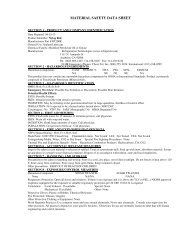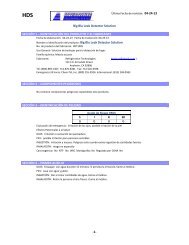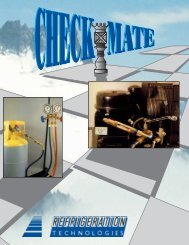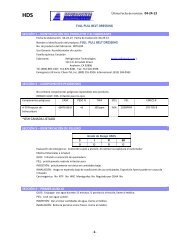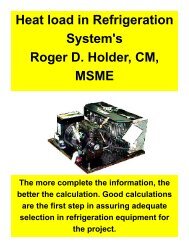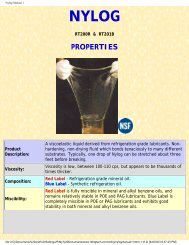Balancing of a Water and Air System (PDF
Balancing of a Water and Air System (PDF
Balancing of a Water and Air System (PDF
You also want an ePaper? Increase the reach of your titles
YUMPU automatically turns print PDFs into web optimized ePapers that Google loves.
32<br />
<strong>Air</strong> Density<br />
<strong>Air</strong> density is defined as the mass per unit volume <strong>of</strong> air. As the temperature <strong>of</strong> a given<br />
mass <strong>of</strong> air increases, its volume increases [i.e. thermal expansion] <strong>and</strong> its density<br />
decreases. As the temperature <strong>of</strong> a given mass <strong>of</strong> air decreases, its volume decreases<br />
<strong>and</strong> its density increases.<br />
100ºF dry bulb <strong>and</strong> 30% RH a 1lb <strong>of</strong> air is 14.4F³ a density <strong>of</strong> 0.0694<br />
62ºF dry bulb <strong>and</strong> 30% RH a 1lb <strong>of</strong> air is 13.2F³ a density <strong>of</strong> 0.0757<br />
As the relative humidity increases at a given temperature the given mass <strong>of</strong> air increases<br />
<strong>and</strong> it’s, volume increases <strong>and</strong> density decreases. As the relative humidity decreases at<br />
a given temperature, the given mass <strong>of</strong> air <strong>and</strong> volume decreases <strong>and</strong> its density<br />
increases.<br />
76ºF dry bulb <strong>and</strong> 100% RH a 1lb <strong>of</strong> air is 13.9F³ a density <strong>of</strong> 0.0719<br />
76°F dry bulb <strong>and</strong> 0% RH a 1lb <strong>of</strong> air is 13.5F³ a density <strong>of</strong> 0.0740<br />
The Foot³ for one pound <strong>of</strong> air must be located first before air density can be calculated<br />
using the formula. <strong>Air</strong> density is equal to one pound <strong>of</strong> air divided by the foot³ per pound<br />
<strong>of</strong> air (<strong>Air</strong> Density = 1lb / ft³). One pound <strong>of</strong> air changes its Foot³ with the dry <strong>and</strong> wet<br />
bulb (See Table 8A, 8B). The formula <strong>of</strong> total heat uses the air density <strong>of</strong> the air leaving<br />
the evaporator. To using, Table 8 A&B for ft³ <strong>and</strong> 9 A to C for air density.<br />
To use table 8:<br />
(1) Measure the dry bulb temperature with a digital thermometer <strong>of</strong> the air leaving the<br />
evaporator.<br />
(2) Measure the wet bulb (water vaporization temperature) temperature with a digital<br />
sling psychrometer <strong>of</strong> the air leaving the evaporator.<br />
(3) Find the measured indoor entering dry bulb temperature on the left side <strong>of</strong> the table<br />
<strong>and</strong> the wet bulb temperature on top line.<br />
(4) Where the lines cross is the Foot³. See table 8A & 8B<br />
(5) Divide the Foot³ by 1 pound for air density.<br />
See Table 9 <strong>and</strong> 9B & 9C for air density<br />
62ºF dry bulb <strong>and</strong> 46º wet bulb 1lb <strong>of</strong> air is 13.21F³ with a density <strong>of</strong> 0.0756<br />
Foot³ <strong>of</strong> one pound <strong>of</strong> air<br />
32




